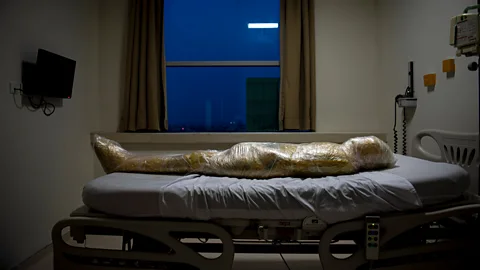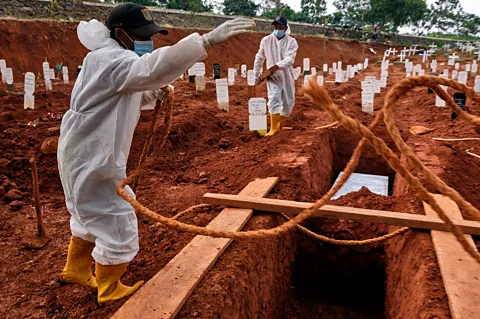The body in the bed: How an Indonesian photographer captured a defining image of loss due to Covid-19
 Joshua Irwandi
Joshua IrwandiIn April 2020, Indonesian photographer Joshua Irwandi captured one of the most chilling and poignant images of Covid-19's toll.
Covid-19 was first confirmed in Indonesia on 2 March 2020 – a dance instructor and her mother tested positive after coming into contact with someone with the virus.
Indonesia is a vast country made up of thousands of islands, but it took little more than a month for the disease to spread to every one of its 34 provinces, among them Java.
Java is the most heavily populated island in the world, home to more than 151 million people. As the pandemic spread, Java – and its densely packed capital Jakarta – became an epicentre of the disease's spread.
Indonesia's health workers battled this new disease with scant resources at first. One study estimated that by July 2021, more than 1,500 Indonesia health workers had been killed by the disease. Nurses in the densely populated country reported shortages of personal protective equipment (PPE) in the early stages of the pandemic as they dealt with the increasing caseload.
Indonesia, of course, was not facing this disease alone. As part of a series looking at the global response to the virus in April 2020, National Geographic commissioned Indonesian photographer Joshua Irwandi to cover his country's battle against Covid.
 Joshua Irwandi
Joshua IrwandiClad in a protective suit like the health workers he was shadowing, Irwandi spent his days inside a Jakarta hospital, observing firsthand how health workers were trying to save lives.
They were not always successful. One victim – the patient's identity has never been revealed to the public – died in their hospital bed. Irwandi took a picture after the body had been wrapped in protective coverings to prevent infection.
"This is the procedure that that was mandated by the Indonesian Ministry of Health," says Irwandi. "How to, you know, dispose of the bodies, you have to wrap them. What happened that day was I was shadowing the doctors and nurses in the hospital, and I was informed that there was a patient who just passed away."
Irwandi first took pictures of the nurses, clad head-to-toe in protective gear, covering the body in whatever material they had to hand. "First with infectious waste bags, actually, and after the body was sort of wrapped up they'd start wrapping with plastic wrap that you see in the supermarket," he says. "I think it took a gruelling hour or so in the heat. They thought that if we turn off the air conditioner, then it might kill the virus. And you're operating under this hot mask."
Irwandi's calm but chilling photograph belies the frenzied activity that was taking place hospitals as Covid-19 struck. The plastic wrap catches the cold, hard glare from the ceiling lights, while the coverings underneath look like something that could have wrapped a body in a ceremonial funeral thousands of years ago.
This eerie figure lies in stark contrast to the modern-day setting: an anonymous hospital room, empty except for a bed and television set. With its sombre, painterly quality, it reminds us that even in our industrialised, often antiseptic modern world, we remain vulnerable.
"The whole time I worked with my mentor here in Indonesia, Geert Van Castelren, who's a Dutch photographer. I was also showing him what kind of images I've been making, asking him 'where do you think this is going'. If you're talking about composition, the more that it resembles something from the classics, usually the stronger the impact of the photograph would make."
And make an impact Irwandi's photo did. "A lot of people accused the image of a set-up," says Irwandi. "There was a singer with two million followers who basically thought that this is a whole setup, and Covid is not that dangerous. People said that it's a mannequin inside.
"You can imagine the sort of misinformation and disinformation at the time. I was given access for a very specific job. Obviously, it's very different to what the public might be seeing or feeling."
 Getty Images
Getty ImagesIrwandi took a conscious decision to take the photo from the same height as the body: it is not the top-down view that a health worker or doctor would have when attending to the body. This positioning puts both the viewer and the subject at the same level.
"When I was in that moment photographing somebody being wrapped in plastic. Could it be my family next? Could it be my friends next? The best you can do is inform your loved ones that this is happening, and take care of yourself," Irwandi says. "I think that is the main message from the photo: if you don't put on your mask, or if you reject science, this is potentially how people could end up."
The image drew reaction far from Indonesia. It was given second prize in the general news category of the World Press Photo in 2021 and was also nominated for a Pulitzer Prize.
Amid the social media-fuelled furore around the image, people continued to contract the disease and die. By the end of the year, more than 800,000 cases had been confirmed in Indonesia and more than 20,000 people had died.
"It wasn't the first patient who died that I photographed, and it's not the last either," says Irwandi. "The following year, you know, Jakarta became the epicentre of Covid in Asia. You could imagine, how many people were influenced by those who thought that Covid was not dangerous, or who thought that 'this is all a set-up, this is fake news', or whatever, and those people died anyway.
Irwandi said the photo had extra resonance for him when he covered mass burials of Covid victims in a graveyard a year later. He visited twice within a week, and fresh plots had already been dug for more victims. "The danger is real, whether or not people like the photograph," he says.
--
If you liked this story, sign up for The Essential List newsletter – a handpicked selection of features, videos and can't-miss news, delivered to your inbox twice a week.
For more science, technology, environment and health stories from the BBC, follow us on Facebook, X and Instagram.
